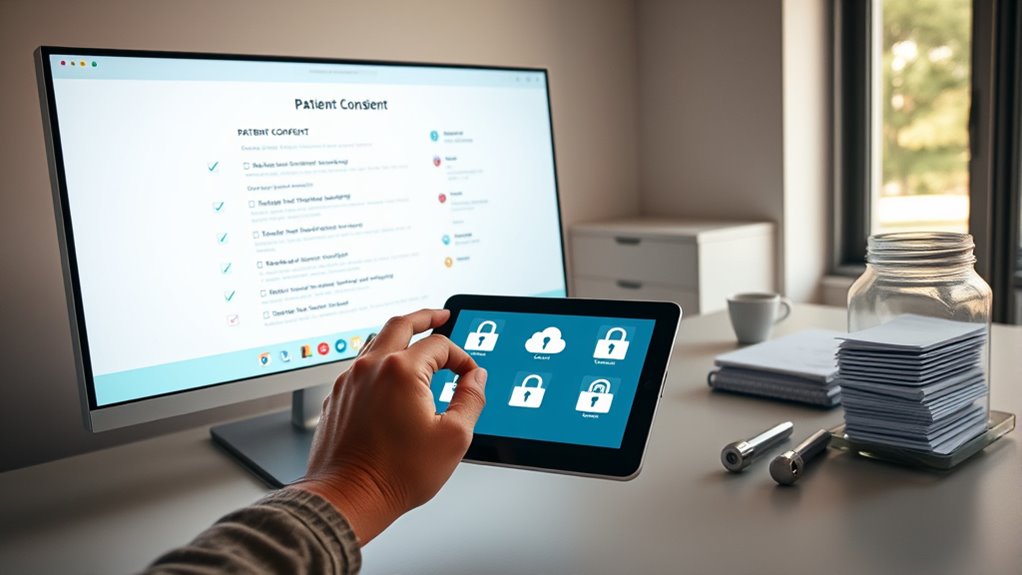When creating digital patient consent forms, you’ll want to include clear details about the treatment scope, potential risks and benefits, and patient rights. Use easily understandable language and guarantee the form is user-friendly. To store them securely, choose platforms with encryption, multi-factor authentication, and robust security protocols. Digital storage should also allow easy retrieval and maintain audit trails. If you want to discover more about best practices, privacy, and legal compliance, keep exploring these essential topics.
Key Takeaways
- Clearly outline the treatment scope, risks, benefits, and patient rights using understandable language.
- Include secure digital signatures with encryption and multi-factor authentication to ensure legality and security.
- Store signed consent forms in compliant digital health records with audit trails for verification and easy retrieval.
- Use user-friendly, accessible digital platforms that facilitate review and understanding before signing.
- Regularly update security measures and conduct audits to maintain data protection and legal compliance.

Digital patient consent forms are transforming how healthcare providers obtain and manage patient approvals. Instead of relying on paper documents, you can now streamline the process by using electronic signatures, which allow patients to sign consent forms securely and efficiently from any device. Electronic signatures are legally binding in many jurisdictions and help reduce the risk of lost or damaged paperwork. They also speed up the process, enabling you to access signed documents instantly, which is especially beneficial in busy clinical settings.
Digital signatures streamline patient approval processes, ensuring secure, instant access in busy healthcare environments.
However, as you adopt digital consent forms, data security becomes a top priority. You need to guarantee that all patient information, including signatures and personal data, is protected from unauthorized access or breaches. Implementing secure platforms that use encryption, multi-factor authentication, and regular security audits helps safeguard sensitive information. When patients sign consent forms electronically, they want assurance that their data is safe and confidential. Consequently, choosing a system with robust security features not only complies with legal standards but also builds trust with your patients.
Incorporating electronic signatures into your consent process simplifies record keeping. You can easily store signed documents in your digital health records system, making retrieval straightforward and reducing administrative overhead. This eliminates the need for physical storage space and minimizes the risk of losing important documents. Plus, digital storage solutions often include audit trails, so you can verify when and how a consent form was signed, adding an extra layer of accountability. Additionally, understanding cost and budgeting factors can help you choose the most effective and economical solutions for your practice.
To guarantee compliance, you should include essential information in your consent forms, such as the scope of treatment, potential risks, benefits, and patient rights. Clear language and detailed information help patients make informed decisions. When presenting the form digitally, guarantee it is user-friendly and accessible, allowing patients to review and understand the content before signing electronically.
Frequently Asked Questions
How Can I Ensure Digital Consent Forms Are Legally Enforceable?
To guarantee your digital consent forms are legally enforceable, make sure they include a digital signature from the patient, confirming their agreement. Verify that the consent validity is clear, voluntary, and informed, with all necessary details provided. Use secure, compliant platforms to store these forms, maintaining integrity and confidentiality. Regularly review your procedures to stay aligned with legal standards, ensuring that your digital signatures and consent processes hold up in court.
What Security Measures Protect Digital Consent Form Data?
You protect digital consent form data by implementing strong security measures like encryption protocols to safeguard information during storage and transmission. Additionally, you should set access controls to restrict data access only to authorized personnel, reducing the risk of breaches. Regularly update security systems, monitor access logs, and train staff on data privacy best practices to guarantee your patient’s sensitive information remains secure and compliant with regulations.
Can Patients Access Their Digital Consent Forms Anytime?
Yes, patients can access their digital consent forms anytime. You guarantee this by implementing secure user authentication, which verifies their identity regularly. When they log in, they can view or download their forms, often using electronic signatures for added security. This constant accessibility helps patients stay informed and engaged with their healthcare decisions, while robust security measures protect their sensitive data from unauthorized access.
How Do I Handle Consent Form Updates or Revocations?
Think of consent revocation and form updates as opening a gate to your patient’s autonomy. When they revoke consent or request updates, you swiftly record these changes in your system, like turning a new page in a book. Keep clear records of all modifications, ensuring your digital forms reflect their current wishes. Regularly review and update the forms to keep communication transparent, respectful, and legally sound, like a well-tended garden.
Are There Specific Regulations for Storing Digital Consent Forms?
Yes, there are specific regulations for storing digital consent forms. You need to guarantee your digital storage complies with standards like HIPAA or GDPR, depending on your location. Use secure, encrypted systems to protect patient data and maintain audit trails for transparency. Regularly review your storage practices to stay aligned with evolving compliance standards, minimizing risks of data breaches or legal issues.
Conclusion
Remember, well-crafted digital consent forms are like gentle guides through the patient journey—they help guarantee trust and clarity. By thoughtfully including essential details and securely storing these records, you’re creating a foundation built on respect and transparency. While technology may evolve, the core of compassionate care remains unchanged. Embrace these tools wisely, and you’ll nurture a relationship that’s as resilient as it is respectful, quietly paving the way for a brighter, more connected healthcare experience.








